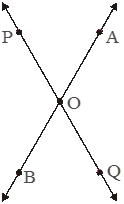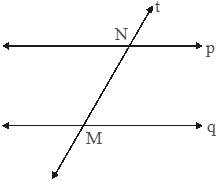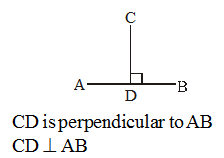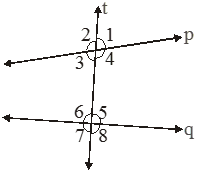- Books Name
- CBSE Class 7 Mathematics Book
- Publication
- Param Publication
- Course
- CBSE Class 7
- Subject
- Mathmatics
Pair of lines
1. Intersecting lines : Two lines are called intersecting lines if they have a common point. This common point is called the point of intersection.

AB and PQ is called the intersecting lines and O is called a point of intersection.
2. Transversal : A line that intersects two or more lines at distinct points is called a transversal.

In this fig. t is the transversal which cut two lines p and q at distinct points, ‘N’ and ‘M’ respectively.
3. Perpendicular lines:

Angles made by a transversal
Two lines p and q cut by a transversal t. It form angles that have some special names as :

(i) Exterior angles : The angles whose arms do not contain the segment on the transversal cut by the given lines are called exterior angles. Such as ∠1, ∠2 and ∠7 and ∠8
(ii) Interior angles : The angles whose one of the arms contains the segment on the transversal cut by the given lines are called interior angles. Such as ∠3, ∠4, ∠5 and ∠6
(iii) Corresponding angles : A pair of angles in which one arm of both the angles of the pair is on the same side of the transversal and the other arms are directed in the same sense is called a pair of corresponding angles. Such as ∠1 and ∠5, ∠4 and ∠8, ∠2 and∠6 and ∠3 and ∠7 are corresponding angles.
(iv) Alternate interior angles : A pair of angles in which one arm of each of the angles is on opposite sides of the transversal and whose other arm contains the segment on the transversal cut by the given lines is called a pair of alternate interior angles.
(v) Alternate exterior angles : A pair of angles in which one arm of each of the angles is on opposite sides of the transversal and whose other arm is directed in opposite sense doesnot contains the segment on the transversal cut by the given lines is called a pair of alternate exterior angles.


 ReginaTagebücher
ReginaTagebücher
 Param Publication
Param Publication
